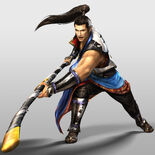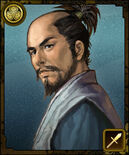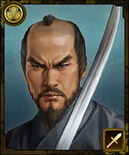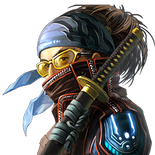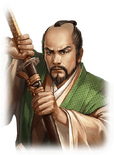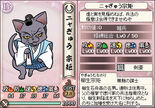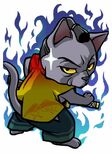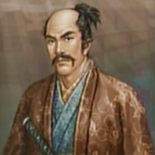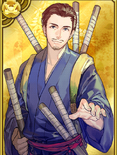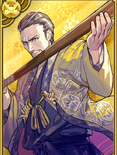| Munenori Yagyū | |
| Clan(s)/Alliance(s): | Yagyū Tokugawa Akechi |
|---|---|
| Height: | 200 cm (6'7")
|
| Weapon(s): | Tachi |
| Heirloom: | Hyōhō Kadensho
|
| Moveset Type: | Charge
|
| Significant Battle(s): | |
| Playable Debut: | Sengoku Musou Chronicle 2nd |
| Real name: | Yagyū Munenori
|
| Japanese name: | 柳生宗矩
|
| Born: | 1571
|
| Died: | May 11, 1646
|
Munenori Yagyū is one of the many famous swordsmen of the early Edo period. He is best known for being the sword instructor for the Tokugawa shogunate and the famous teacher of a widely known sword style. After his death, he has been heralded as an unmatched duelist who far surpassed any other in the land. His father was Muneyoshi Yagyū and his successor is Mitsuyoshi who is often romanticized under the name Jūbei.
Ironically, it is often noted that most portrayals of Munenori tend to villainize him to varying degrees due to his close affiliation with politics (as politicians were said to be corrupt in most forms of fiction).
Before he was playable, he used to be a generic NPC since Samurai Warriors 2. He is voted forty-sixth in the Samurai Warriors 4 character popularity poll. This counterpart also has an image song called Katsujinken ~ Nen wa Ken Yori mo Tsuyoshi ~, named after his famous philosophy of the same name.
Role in Games
Samurai Warriors
In Samurai Warriors and it's sequel, Munenori makes sporadic appearances as a Tokugawa general in late campaigns of the game, or hypotheticals such as Edo Castle or various dream stages. During his playable debut, disgusted with the land's wars, Munenori willingly sides with Ieyasu for unification in Sengoku Musou Chronicle 2nd. He instructs his lord's soldiers to fight with integrity.
Samurai Warriors 4 Munenori begins under his father. His family is indebted to Hisahide's patronage so he accompanies the mastermind in his schemes to overthrow Nobunaga. Munenori fights for him at Kannonji Castle, Kanegasaki, and Kii Province. As he watches over Hisahide struggle, Munenori ponders a person's deeper motivations for fame within the era and believes he may find the answer someday by siding with the rebels. He becomes acquainted with Koshōshō during these battles and answers her request to join her at Asan.
The swordsman supports the Akechi army at Honnōji and Yamazaki to personally learn the results of Hisahide's plot. Wishing to support her as a friend, he assists Koshōshō again at Shikoku for Mitsunari's Hiketa attack and Hideyoshi's invasion. He joins the Chōsokabe's surrender to Hideyoshi and helps them subjugate Odawara Castle. During these battles he provides his insight to those he feels are oppressed, eventually coming to the conclusion that everyone is merely fighting for an age of peace. Munenori realizes peace is short-lived with the Toyotomi successors and decides to fight for the Tokugawa's vision of stability. He specifically serves under Hidetada, protecting his liege at Ueda Castle and Osaka Castle. Munenori survives the wars through his efforts.
Warriors Orochi
In Warriors Orochi, Munenori is one of the swordsman recruited by Musashi Miyamoto to fend off the demon army at Tedorigawa. Musou OROCHI Z has him serve as Kunoichi's substitute officer if the latter has been chosen as the player's team member.
Warriors Orochi 3 has him and Shigetaka Togo work together to fight the demon army at Dongkou. Both find themselves surrounded only to be saved by the Coalition. Their timely rescue allows them to fight at the altered future in Odawara Castle.
Nobunaga's Ambition
Throughout the series he possesses above-average stats for war and is proficient in leading foot soldiers. The newest title, Tendou, increases his intelligence rating to be substantially higher than his past appearances. His low leadership and overall low ranking troop preferences may hamper his usefulness for leading long sieges, however, so the player will need to plan his appearances in the battlefront carefully. Munenori has average political traits and high loyalty, and he may serve the player well as a back-up general for domestic affairs.
In the online adaptation of the game, he is a level 55 intellectual general who serves the Tokugawa clan. His character is devoted to passing on his father's legacy, even in an age in which the sword may not be needed. He desires to discipline the player in hopes that they will someday learn the importance of unification. As a boss character Munenori fights with two swords and possesses a hard-to-dodge, five hit combo attack. He can cast accuracy spells on his party and can weaken the opposing party's defenses.
Character Information
Development
The producer of the Samurai Warriors series wanted to answer fans' requests for new characters while appealing to the team's desire to include characters who could fit the multiple scenario options in the main story mode. He comments that these characters feel as though they would not normally fit in a typical Samurai Warriors title. In Munenori's case, the team wanted him to be the undisputed sword saint with the authority of a military commander. His addition appeals to fans who wanted a different type of sword saint in the series. Koinuma admits Munenori's persona was an invaluable time saver for scripting the later parts of the main story. He wanted Munenori to act as the character who is in as many different stages as possible.
Personality
For his playable Warriors counterpart, Munenori is a perceptive swordsman who is passionate about the thrill of one-on-one duels. He believes that the true art of battle can be found without taking another's life while focusing more on fair duels, and is not a fan of melodramatic heroics. Bored with the predictable convictions of death in the era, Munenori wishes to be a rough-around-the-edges, haphazard cynic rather than follow the ideals of yore. Yet he feels that he is incapable of changing due to the strict sword training he was raised to inherit, causing him to feel that he can be nothing more than a swordsman.
As a humorous form of self-deprecation towards his dated acceptance of his lifestyle, Munenori calls himself "Old man" (おじさん, ojisan). The swordsman believes the era of peace the land desires is really decided by the hopeful warriors of their age, whom he refers to as "young-ins" or "child", regardless of their actual age difference with him. He tries to believe in a person's better traits through his interactions with others. Sometimes however, those who bore him also get the "old man" treatment from him, regardless of their age or gender.
Hidetada's health and well-being is a primary concern for him. He wishes for his lord to not overextend himself at all times. He also feels initially indebted to Hisahide and has a certain level of sympathy for him.
Character Symbolism
His Samurai Warriors counterpart is symbolized by the kanji symbols for "strength" (剛) and "living" (活). The latter kanji is most likely based on his concept of the "Life-Giving/Saving Sword" (活人剣, Katsujinken) as documented in one of his life-time novels as a sword that is meant to protect life rather than take it, which is also the name of his aforementioned image song.
Munenori's legendary sword, Ōtengu-Masaie, is the namesake for his three basic weapons. His Normal weapon is literally named after it, while his Power and Speed name a white and bird version of the tengu respectively (literally meaning a heavenly dog). Munenori was fabled to have wielded it during Sekigahara, but the sword's legendary origins predates this event with his father, Muneyoshi. Before he was reputed as a feared swordsman, he traveled to the east for training. Despite walking for three days and two nights straight, he was spry enough to expertly defend himself from a tengu on the third night. As he clashed blades with the beast in complete darkness, he was able to land a devastating slash on the beast. Sensing that their match had ended, Muneyoshi left the scene to rest. When he returned to their battleground next morning, the tengu was gone. A boulder completely split in two matched the spot of Muneyoshi's final blow. The sword he used in the fight has since been named after the tengu. Within the game's script, many characters are familiar of his father's fabled exploit and frequently allude to it. The tengu motif is also present in Munenori's natural wind element and in both his Musou Attacks, as tengu are said to stir up great leafy winds with feather fans.
His third weapon in Chronicles 3 is derived from a Confucian phrase, "To govern one's clan, one should first learn to govern oneself." This ties into Munenori's self-improvement philosophy.
Omohikane is a Japanese deity and the namesake of Munenori's first unique sword. His name includes the words "to contemplate" or "to combine", thus he is often accredited as the deity of wisdom who grants people the ability to have thought and maintain knowledge. He is often thought as a foreign god rather than a deity native to Toyo-Ashihara.
The other deity mentioned in his second unique sword, Kukunochi, appears to have a similar naming motif as Omohikane. However, his name actually uses the archaic word for "wood" so he is often identified as a wood or tree god. Kukunochi is one of Izanagi and Izanami's many children and resided near Oohoyamatsumi (god of mountains) and Kayanohime (goddess of plains).
Voice Actors
- Hiromu Miyazaki - Samurai Warriors series (Japanese)
Quotes
- See also Munenori Yagyū/Quotes
Gameplay
Sengoku Musou Chronicle 2nd
| Keys: | Y - Normal Attack, | X - Charge Attack, | B - Jump, | A - Musou |
Ground Moveset

Samurai Warriors Chronicles 2nd Munenori Yagyu
- X, (X), (X): Thrusts left fist forward, rams right shoulder outward, and swings weapon outward.
- Y, X, (X), (X): Launches opponent up in the air with an upward-outward batting motion, then swats his weapon inward in a turn, finishing with a downward jerk-leaning smash that causes a quake (which either inflicts crashing knockback on airborne hit or trip effect on grounded hit).
- Y, Y, X, (X), (X): Turns around with a right-legged stomp that causes an energy geyser to rise (which stuns on grounded hit). The next inputs involve a low-sweeping outward swing, finishing with a forward stepping stab (causing grounded targets to crumple afterwards).
- Y, Y, Y, X, (X), (X): Plants sheath into the ground for a quake, then kicks it off the ground for a trench-based blast forward, finishing with an inward swat that inflicts crashing knockback on airborne hit (or crumples on grounded hit)
- Y, Y, Y, Y, X: Releases a huge wave of energy that dissipates after sheathing weapon.
- Y, Y, Y, Y, Y, Y, Y, Y: Swings weapon inward, outward, downward, then to the left overhead in four swings before finishing with a turning outward swat.
- A (Musou): Fiercely swings weapon back and forth while advancing forward before generating a shockwave.
- A (True Musou): Similar to Musou attack but with extra sweeping strikes included in the end.
- A (Ultimate Musou): Pauses momentarily to un-sheath weapon in time to unleash several swift slashes followed by a massive turning slash that slides him into a stop.
- B, Y: Does an inward swat downward.
- B, X: Slams palm into the ground via drop, causing an OTG-hitting quake.
- Dashing Y: Swings his weapon to the left inward in a scooping brake slash.
- Deadlock Attack: Flicks the opposing target's weapon upward with the sheath, then does two quick slashes (downward reap then inward slash that re-sheathes) before unleashing a broad battōjutsu slash to his right, then re-sheathing his blade.
- Spirit Cancel: Charges forward with his left shoulder.
- Special Skill: Stands still while rolling his neck around, causing a non-damaging and non-flinching aura that provokes enemies into having increased attack power. Upon getting hit, a counter/reversal trigger causes Munenori to quick-draw his sword iaidō-style, staggering any targets hit via grounded hit. Has very low chance to kill his target unless triggered in a certain fashion and/or done via air hit (where the counter slash inflicts crashing knockback instead).
Mounted Attacks
- Y, X:
- Y, Y, X:
- Y, Y, Y, X:
- Y, Y, Y, Y, Y, Y, Y, Y:
Samurai Warriors 4
| Keys: |
Mighty strike is the same as his Deadlock Attack. Keeps relatively same moveset as the previous entry with select changes.
 ,
,  , (
, ( ), (
), ( ): Same as before.
): Same as before. ,
,  ,
,  , (
, ( ), (
), ( ): Same as before.
): Same as before. ,
,  ,
,  ,
,  , (
, ( ), (
), ( ): Same as before.
): Same as before. ,
,  ,
,  ,
,  ,
,  , (
, ( ), (
), ( ): Performs an iaidō-based quick-draw that causes multiple ripples to emerge which launches, then back-slashes inward away from his targets; finishes with another wide outward launching slash with a re-sheathing (which instead inflicts slowed-hitstun and/or staggers on grounded hit). Said re-sheathing has a final hitbox around Munenori when he fully claps his sword back in, which inflicts crashing knockback.
): Performs an iaidō-based quick-draw that causes multiple ripples to emerge which launches, then back-slashes inward away from his targets; finishes with another wide outward launching slash with a re-sheathing (which instead inflicts slowed-hitstun and/or staggers on grounded hit). Said re-sheathing has a final hitbox around Munenori when he fully claps his sword back in, which inflicts crashing knockback. : Finisher changes to Munenori unleashes three iaidō-quick-draws with each one giving off multiple slashes via, causing leaves to appear per slash and inflicting crashing knockback.
: Finisher changes to Munenori unleashes three iaidō-quick-draws with each one giving off multiple slashes via, causing leaves to appear per slash and inflicting crashing knockback. (Ultimate/Kaidan): Same as before, only with leaf-covered winds to appear along each slash.
(Ultimate/Kaidan): Same as before, only with leaf-covered winds to appear along each slash.- Rage Attack/Musou Gokui effect: Activates Ultimate/Kaidan Musou if
 is used. Animation for Ultimate/Kaidan itself remains unchanged, but the ending effect is altered slightly.
is used. Animation for Ultimate/Kaidan itself remains unchanged, but the ending effect is altered slightly. - Awakened Skill effect (4-II only):
Hyper Moveset
 : Slides forward quickly as he swats his weapon back and forth in low-braking postures, with each odd-numbered input swinging inward, and each even-numbered input swinging outward.
: Slides forward quickly as he swats his weapon back and forth in low-braking postures, with each odd-numbered input swinging inward, and each even-numbered input swinging outward. ,
,  : Turns around and performs a spiraling-rising upward swat in a leap that launches. Can be interrupted into attacks upon landing.
: Turns around and performs a spiraling-rising upward swat in a leap that launches. Can be interrupted into attacks upon landing. ,
,  ,
,  : Holsters back his weapon over his shoulder while palming forward with his left palm, causing crashing knockback.
: Holsters back his weapon over his shoulder while palming forward with his left palm, causing crashing knockback. ,
,  ,
,  ,
,  : Same as his Hyper C2.
: Same as his Hyper C2. ,
,  ,
,  ,
,  ,
,  : Same as his Hyper C3.
: Same as his Hyper C3. ,
,  ,
,  ,
,  ,
,  ,
,  : Wields weapon with both hands for a two-handed bat-swing to his left.
: Wields weapon with both hands for a two-handed bat-swing to his left. ,
,  ,
,  ,
,  ,
,  ,
,  : Ends his Hyper Attack string with a quick-draw that inflicts crashing knockback.
: Ends his Hyper Attack string with a quick-draw that inflicts crashing knockback.
Fighting Style
Munenori is the definition of a swordsman who only draws his blade if he must, via his following of the Yagyū Shinkage-Ryū (柳生新陰流, lit. Yagyū New Yin-Style) and his philosophy of the Katsujinken (活人剣, lit. Life-Giving/Saving Sword), where one only makes use of various takedowns and other unarmed strikes while relying on their sword as little as possible; the only time one draws their sword is when one death can prevent many other deaths afterwards.
As such, many of his attacks save for his more stronger ones (such as his C5 and Musou Attacks) all involve using his still-holstered weapon as a battering club of some sort with the usage of wide swings and rather-snazzy flailing strikes; all of his aforementioned stronger attacks instead actually involve him drawing his sword with standard-issue-yet-effective swordsmanship, which doesn't normally follow a certain style of swordsmanship as aforementioned via the Shinkage-Style.
In terms of gameplay, Munenori often has sluggish-yet-wide area-clearing attacks. Attack speed enhancements however, may mess up the flow of some of his attacks such as his fourth installment C5.
Weapons
- See also: Munenori Yagyū/Weapons
Samurai Warriors: Spirit of Sanada
| Great Tengu's Blade | |||
|---|---|---|---|

|
Base Attack: | ||
| Wise God's Blade | |||

|
Base Attack: 276 | Wind: 80 | Ice: 72 |
| Attack Up: 89 | Attack Range: 84 | Courage: 81 | |
| Fury: 75 | Insight: 89 | Clarity: 81 | |
| The Way of the Sword | |||

|
Base Attack: 283 | Earth: 83 | Fire: 75 |
| Attack Up: 92 | Attack Speed: 85 | Fury: 84 | |
| Underdog: 81 | Verity: 90 | Momentum: 80 | |
Rare Weapon Acquisition
- Stage: The Tenshō-Jingo Conflict - Defense of Numata
Historical Information
Gallery
Gallery
|
|---|
100man-nin no Nobunaga no Yabou portrait Nobunaga no Yabou 201X portrait Nyagyu Munenori in Samurai Cats |

|
This article about a Samurai Warriors character is a stub. You can help the wiki by expanding it. |



